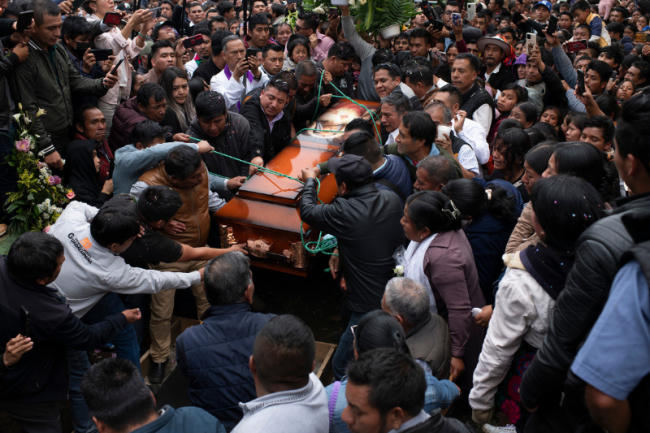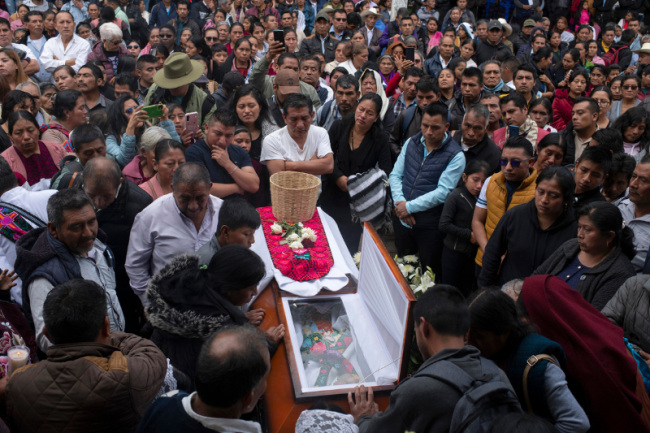
Marcelo Pérez Pérez knew that his enemies wanted him dead. The priest in San Cristóbal de las Casas, Chiapas, had been receiving threats for a decade, thanks to his work of constantly decrying injustices in the Indigenous communities he pastored.
On September 13, he led a march from San Cristóbal to the state capital, Tuxtla Gutiérrez, to demand peace in Chiapas, best known as the site of the 1994 Zapatista uprising. A month later, on Sunday, October 20, he left mass in San Cristóbal’s Cuxtitali neighborhood, where he was involved in mediating a water dispute. A security camera video shows him climbing into his white truck. Seconds later, a man walked up to the window and shot Father Marcelo five times.
“The father’s murder demonstrates the real situation of savage violence in Chiapas,” says Dora Robledo, director of the Fray Bartolomé de las Casas Human Rights Center in San Cristóbal, who worked closely with the priest. “He was a defender who had opted for the poor, and because of his work, they had to silence him.”
Two days after the killing, in Mexico City, President Claudia Sheinbaum announced that the federal prosecutor’s office would take over the investigation from local authorities. Shortly after the priest’s widely attended burial on October 22, the state prosecutor’s office announced the arrest of a suspect. But far from an isolated incident, the leader’s murder represents a threat to all those seeking to resist the mounting violence in Chiapas.
Dedicated to the vocation of peacemaking, Father Marcelo was a highly sought-after mediator who facilitated dialogue in communities torn apart by conflict. As the federal government minimized the bloodshed in Chiapas, attributing the violence to local disputes between individuals, the priest continued to speak openly against the powers behind the carnage and to plead for authorities to intervene.

The People Say Goodbye
After news of Pérez’s murder broke, thousands of parishioners from Indigenous communities took buses to San Andrés Larráinzar, the priest’s hometown in the Chiapas Highlands, for the two-day funeral proceedings. On October 21, some 1,500 people crowded around the San Andrés Larráinzar plaza outside the local church to view Father Marcelo’s body. The coffin’s glass window revealed the priest’s face, bandaged and stitched to cover his wounds.
The crowd more than quadrupled for the October 22 burial mass, held in Spanish and Tzotzil. On a stage, deacons and catechists from local churches joined religious officials from around the country. Thousands of people filled the town plaza and overflowed the sidewalks.
In his funeral message, Raúl Vera, the Coahuila bishop also known for his human rights advocacy, recalled Father Marcelo’s commitment to justice. “He didn’t just listen, he moved to solve problems, and denounced [injustice] with his prophetic word. That’s what they didn’t like,” Vera said. “The person that killed him only killed him for pay, but the true murderers are those who were bothered because there was a prophet who denounced them and uncovered them and blocked their abuses.”
Father Marcelo was one of the first Indigenous priests in the San Cristóbal diocese, long known for supporting local Indigenous movements. The diocese was long led by the late Bishop Samuel Ruiz, known locally as Tatik Samuel, the Tzotzil word for father, who in the 1960s brought to the region the liberation theology that deeply informed the creation of the Zapatista National Liberation Army (EZLN).
While he was the parish priest in Chenalhó, Father Marcelo grew close to the Abejas de Acteal, the pacifist religious community where, in 1997, paramilitaries killed 45 people, mostly women and children, as they prayed in the church. “Getting to know Las Abejas, their struggle, and their suffering, changed his life,” says Luis Manuel López Alfaro, auxiliary bishop of San Cristóbal. “That’s when he decided to walk for justice and peace.”
After serving in Chenalhó, Father Marcelo was transferred to the municipality of Simojobel. There, in 2014, he began speaking openly against the human trafficking and drug use tied to cantinas managed by local power groups. From Simojobel, Father Marcelo continued on to Pantelhó, where he mediated conflicts between local armed groups and the government.

“What stands out about Marcelo is his role as a mediator, a peacemaker, his method of analysis, reflection, the responsibility of getting involved in the process of peace,” says Gerardo González, a researcher at the Colegio de la Frontera Sur who knew Pérez personally. “I think he woke up thinking about justice. I can understand why people hated him, because a lot of people hate peace.”
Conflict in Chiapas
Pérez’s hometown of San Andrés Larráinzar is a landmark site for Indigenous struggles in Mexico. In 1996, the town hosted truce talks between the Zapatistas and the Mexican government that resulted in the San Andrés Accords. But the government never implemented the accords and instead armed government-aligned paramilitary groups to wage a covert war to repress the Zapatista struggle.
Many of today’s armed groups are descended from paramilitaries, which operated to protect the interests of local landowners. Others formed as community self-defense militias to protect against those groups and later took on their rivals’ tactics.
In recent years, though, local disputes have acquired new firepower. International organized crime groups have always controlled drug flows in the region, but since former president Andrés Manuel López Obrador and Chiapas governor Rutilio Escandón took power in 2018, these criminal forces have become more aggressive. High-calibre weapons have appeared in the hands of impoverished farmers. Executions, kidnappings, and disappearances have become common, and armed groups have displaced entire communities.
The San Cristóbal diocese publicly denounced the gravity of the situation in a 2020 open letter. “We foresaw that situation of organized crime, certain places where there was an increase in violence,” says José Luis Vizares, the diocese’s vicar for justice and peace. “The pastoral letter tried to warn about this, and it came like an avalanche.”
“There are families who can’t go to their fields because they’re afraid that on the way they’ll run into one of these groups or get caught in the crossfire,” Vizares adds.
The Zapatistas have also raised alarm about the situation. In a series of communiqués released ahead of the 30th anniversary of the 1994 uprising, the EZLN condemned growing levels of violence and “disorganized crime” in Chiapas and cautioned supporters against traveling to Zapatista territory for the movement’s anniversary celebrations.
The escalation in violence is generally attributed to disputing cartels fighting over territory previously controlled by one group.
“Our reading is that, with the arrival of a new regime, they decided to create a pact with an organized crime cartel, and the police and Armed Forces began acting to protect the cartel,” explains Luis Abarca, the Chiapas representative of the Comité Digna Ochoa human rights organization.
The escalation in violence is generally attributed to the Jalisco Nueva Generación cartel expanding into Chiapas, generating battles for territory previously controlled by the Sinaloa cartel.
Luis Abarca, the Chiapas representative of the Comité Digna Ochoa human rights organization, notes that Chiapas is “strategic territory” due to the movement of migrants and weapons across Mexico’s southern border and in the region’s natural resources. “We don’t think this violence is unrelated to the dispute and plunder of strategic natural resources like minerals, forests, water, [and] petroleum.”
The escalating violence also takes place in a context of a reorganizing of the Zapatistas. The movement recently restructured their local governance organisms, moving away from the centralized Caracoles, which served as a sort of municipal headquarters of Zapatista communities, to decentralized governance councils.
Guadalupe Vázquez Luna, a survivor of the Acteal massacre, sees the new panorama as reflective of a change in counterinsurgency strategy deployed on behalf of the state. While cartels may not have explicit political motivations, the end results are the same.
“The first strategy was [to use] the military against Zapatismo, but it was really against people who were organizing. Now it’s organized crime [against the people],” she says. “The state permits organized crime by not doing anything. The military and National Guard disappear when there are confrontations. Militarization doesn’t work, because what we need is justice.”

Father Marcelo isn’t the first human rights defender to be targeted in the recent surge of aggressions. Simón Pedro Pérez López, a member of the Abejas de Acteal, was killed in July 2021. In October of 2023, José Artemio López, a teacher in the town of Chicomuselo who organized a march for peace, was tortured and killed in his home, and in May of this year, a family of catechists in Chicomuselo were also killed. But the assassination of a church leader sends a message to the institution that has historically been the strongest pillar of public life in Chiapas.
“In the context of the church in Chiapas,” Abarca says, “it’s the end of an era, of the immense power that the San Cristóbal diocese had, where it was the articulator and organizer of community life.”
Madeleine Wattenbarger is an independent journalist based in Mexico City, where she covers social movements and human rights.

